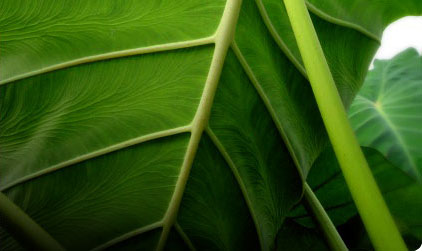Use As Food
Limited use as a table taro. Taro of Lauloa group were used by the early Hawaiians for medicinal purposes, chiefly in pulmonary disorders. They are now popular mainly as table taros and for poi.
Distribution
Found exclusively under upland, dryland culture (māla), occasionally as a mutation from Lauloa Palakea ‘Ele‘ele.
General Characteristics
Tall, erect, stocky, maturing within 9 to 12 months, producing from 5 to 10 ‘ohā; identified by needle-like black streaks on dark green petioles.
Ha (Petiole)
100 to 140 cm. long, dark green with a few short blackish streaks, tinged with reddish-purple at top (apex) and often near the lihi (edge), indistinctly reddish at edge, a brilliant pink ring at kohina (base) with light pink for 2 to 3 cm. above the base.
Lau or Lu'au(Leaf Blade)
45 to 65 cm. long, 30 to 40 cm. wide, 35 to 50 cm. from tip to base of sinus (māwae), lū ‘aum is narrowly arrow-head shaped, slightly concave (curve inward), dark green with bluish cast; margins with a few large undulations; piko purplish; round leaf section (lobes) acute with narrow lihi māwae (sinus).
'I'o kalo (Corm)
Flesh white with pinkish tinge, especially near apex, and yellowish fibers; skin brilliant pink.
Pua (Flower)
Hā (peduncle) green with black streaks, reddish-purple at top (apex); flower cover (spathe) 30 to 35 cm. long, the lower tubular portion 5.5 to 6 cm. long, yellowish-green with reddish-purple at constriction (skinny part of flower), the upper portion yellow, curved and drooping, usually tightly rolled but sometimes open near constriction (skinny part of flower); spadix (spike of flower) 12 cm. long, the sterile appendage (tip of flower's spike) 12 to 17 mm. long.
Remarks
Four forms of Lauloa Palakea are commonly known, all characterized by soft, white ‘i‘o kalo (Corms), and distinguished from each other by some coloring on the Hā (petioles). Lauloa Palakea Ke‘oke‘o is the most easily distinguished, as the other three varieties are dark green heavily suffused with reddish-purple. The black streaking on the Hā (Petiole) of this variety is extremely narrow, most of the streaks being barely more wide than the thickness of a needle and of equal thickness for their entire length.
